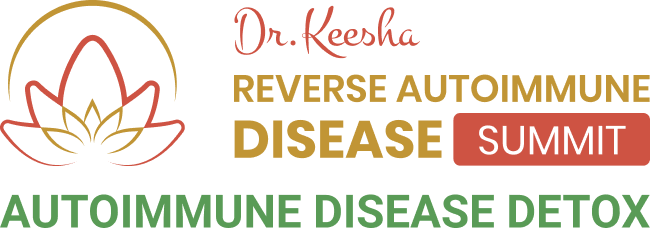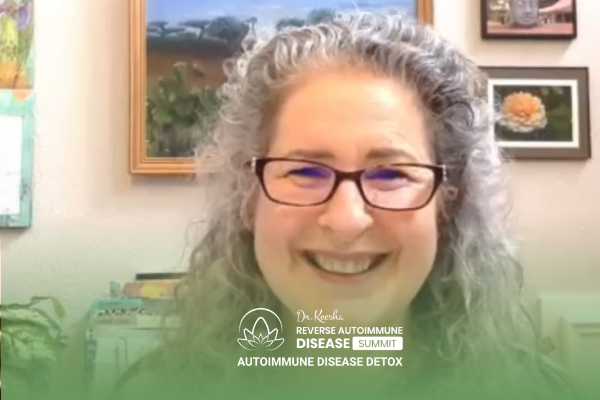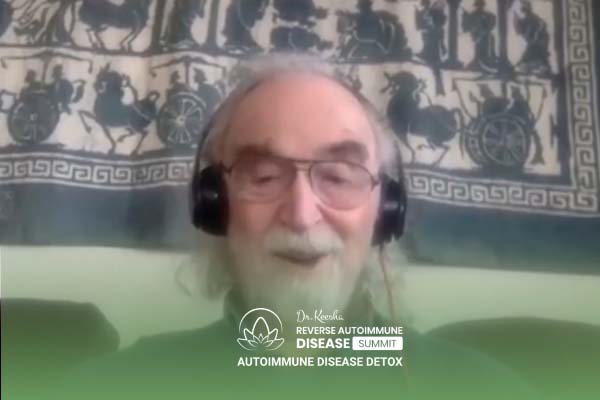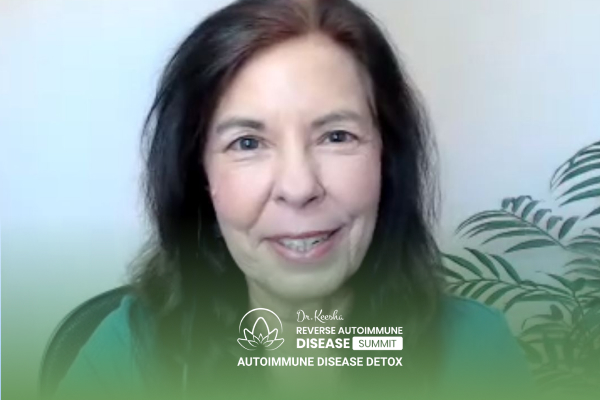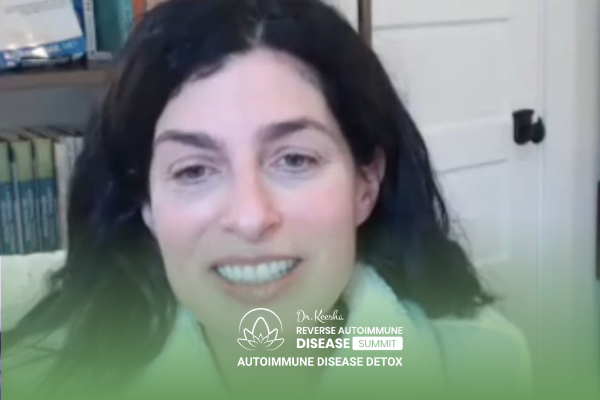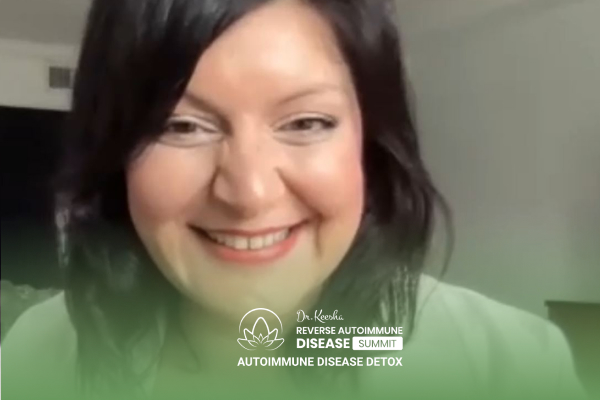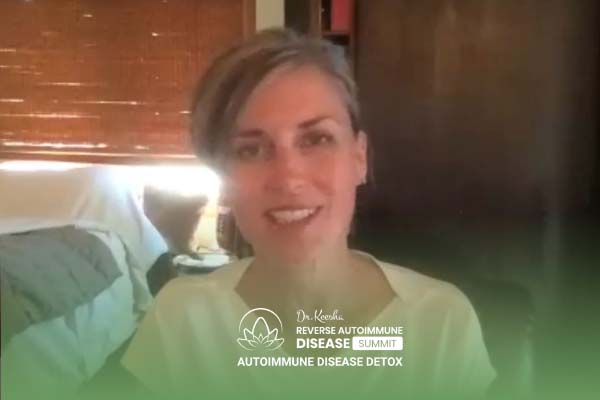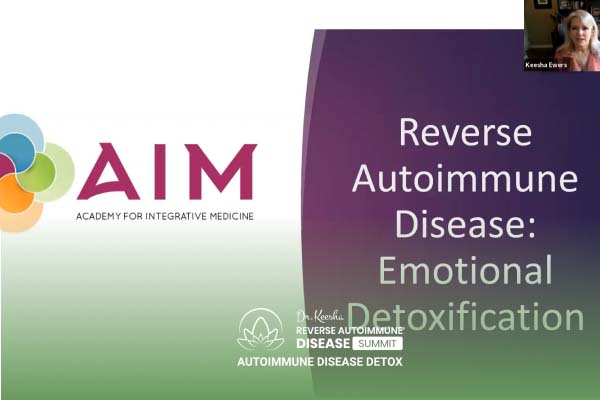Join the discussion below
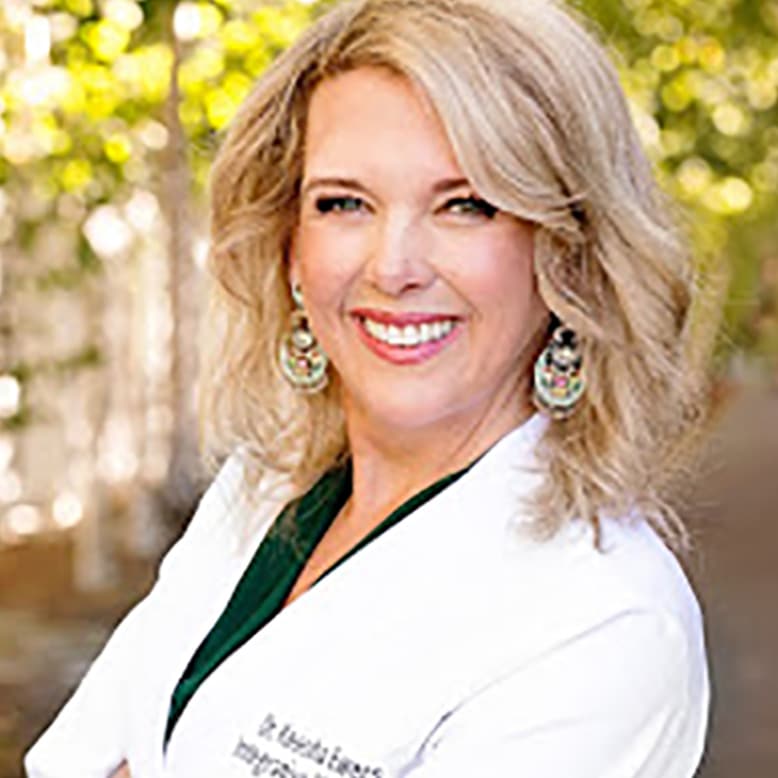
Keesha Ewers, PhD, ARNP-FNP-C, AAP, IFM-C
Dr. Keesha Ewers is an integrative medicine expert, Doctor of Sexology, Family Practice ARNP, Psychotherapist, herbalist, is board certified in functional medicine and Ayurvedic medicine, and is the founder and medical director of the Academy for Integrative Medicine Health Coach Certification Program. Dr. Keesha has been in the medical field... Read More
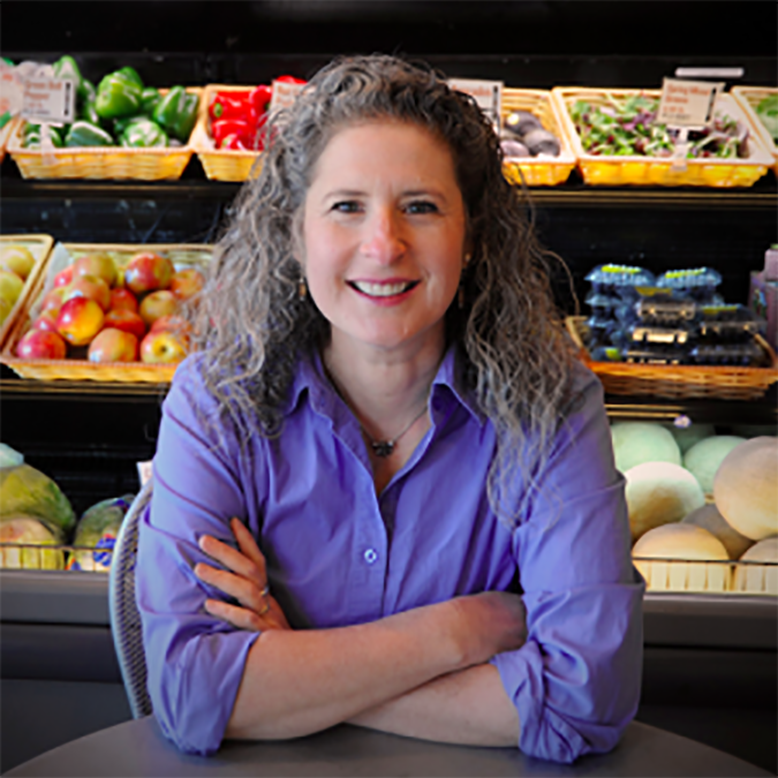
Mira Dessy is The Ingredient Guru. She is the author of the book The Pantry Principle: how to read the label and understand what's really in your food. A holistic nutritionist and a popular public speaker, she knows that it's not just what you eat, but what's in what you... Read More
• Understand what’s really in your food
• It’s not just what you eat
Keesha Ewers, PhD, ARNP-FNP-C, AAP, IFM-C
Welcome back to the Reverse Autoimmune Disease Summit Series, everybody. This is the autoimmune detox iteration of this series, and I am so happy to bring to you dear friend and colleague of mine Mira Dessy. Mira, I don’t even think I know where Dessy comes from, where does it come from?
Mira Dessy
That’s interesting, yeah. So my husband’s family is Belgian.
Keesha Ewers, PhD, ARNP-FNP-C, AAP, IFM-C
Okay, I’ve never asked you that question. So I just wanted to ask that all of a sudden. So I’m introducing you to the ingredient guru. She’s the author of the book, “The Pantry Principle: How To Read the Label, and Understand What’s Really in Your Food”. A holistic nutritionist and a popular public speaker. She knows that it’s not just what you eat, but what’s in what you eat. Mira is a board certified holistic health practitioner, who’s been working for clients, I said for clients, but you’ve put with in your bio, and I like ‘for’, for clients.
Mira Dessy
Okay, and that is a nice change, I like that. Did you write, I am working for them and support them?
Keesha Ewers, PhD, ARNP-FNP-C, AAP, IFM-C
Yeah, I kind of like that little stumble. For over 14 years, and supports them in reaching their health goals through holistic nutrition, lifestyle modifications, and chemical cleanup. Welcome to the series. We’re gonna talk about reversing autoimmune disease by detoxing your pantry. And I know I’ve been in talks with you, for national associations, and things where you’ve really put slides up, and you’ve shown labels, and you’ve come in, and you’ve spoken to my health coach certification group about this too, just, your knowledge about this is really, really detailed, and I think when we say detoxing your pantry to reverse autoimmune disease, I’m wondering if some people sort of roll their eyes back in their head, yeah, yeah, yeah, I can’t have sugar, yeah, yeah, yeah, right?
Mira Dessy
Yeah.
Keesha Ewers, PhD, ARNP-FNP-C, AAP, IFM-C
But there’s so much more to this than that, and so I wanted to start like your Vedic medicine says, the microcosm and the macrocosm match. And so let’s dial in on the microcosm of the label first, and then expand out if you don’t mind.
Mira Dessy
Sure, but before we do that, I have one thought that I really just wanna share with you.
Keesha Ewers, PhD, ARNP-FNP-C, AAP, IFM-C
Okay.
Mira Dessy
Well, part of the reason that I absolutely love that you are doing this is because I know that I am a living, breathing example of what that kind of detox looks like, so the way I got into this whole profession, ’cause I did something different in another lifetime, is that I got really, really sick, and I wound up being diagnosed with a lot of health conditions. My primary was ulcerative colitis, which is an autoimmune disorder, and in the process of learning how to reclaim my health, I began that process of detoxing my pantry, detoxing my home, and the last colonoscopy that I had, my doctor told me that there is absolutely no evidence of ulcerative colitis in my body.
Keesha Ewers, PhD, ARNP-FNP-C, AAP, IFM-C
Hurray.
Mira Dessy
That is what detoxing can do to support a reverse–
Keesha Ewers, PhD, ARNP-FNP-C, AAP, IFM-C
It’s interesting, ’cause I usually start off these interviews asking about your personal story, and I just ran right over it for you.
Mira Dessy
That’s okay.
Keesha Ewers, PhD, ARNP-FNP-C, AAP, IFM-C
My apologies.
Mira Dessy
No worries, so when you asked me to be part of this, I was like, yes, please, because it’s such a powerful thing, and unfortunately, it’s something that mainstream medical establishment does not take into account at all. Most people are completely unaware of this level of how to support their body, and how to reclaim what’s going on with their health on their wellness journey.
Keesha Ewers, PhD, ARNP-FNP-C, AAP, IFM-C
My mom has ulcerative colitis, and is on Rituximab IV infusions, and over time, I’ve got a nurse so that she’s off of them, and she’s doing really, really well, because she’s eating really, really clean, and then she’ll revert back. My dad used to make homemade bread, and he just passed away about three weeks ago, and I think because in her genetics, she is incredibly I’ve never seen anyone not be celiac, but be this gluten intolerant. She’s one little half a snip off of celiac, and I just, I told her one time when he was out of town for a month, just try it like dad’s bread won’t be wafting through the air, fresh bait, and just see what happens. She dropped 15 pounds in a month of puffiness.
And I know still last night, we had dinner with her, and we had picked up some salmon, and some things, and when my husband, we were on San Juan Island, and we like to support the local restaurants, and so we had said, let’s just get some food here, and then we’ll bring it over to mom’s. He hadn’t checked in with my salmon came with fries, and when my mom opened up the container, she grabbed one, and ate it, and my husband was like, no, they put flour on their fries, like, that’s not gluten free. And I just remember mine, I was like, oh, no, mom, and she was so nonchalant about it, and I realized, oh, she doesn’t have that level, right, of that trap poison that we have.
Mira Dessy
And yeah, I think part of the challenges is, it’s more than just an interim thing. This is a lifestyle change.
Keesha Ewers, PhD, ARNP-FNP-C, AAP, IFM-C
Lifestyle change.
Mira Dessy
Yes, and we are surrounded by all of these different things that can impact our dietary plan, our health choices, et cetera, and so learning how to make those changes is a process. It’s a long process.
Keesha Ewers, PhD, ARNP-FNP-C, AAP, IFM-C
Yeah, I did have to get to that point, and it took probably five years to say, the bread that is in the basket that gets just dropped on the table that I have to say, please take that back, or please don’t bring it, that it’s not even a temptation anymore, because I do think of it as rat poison. Like oh, that’s rat poison. I had rheumatoid arthritis, I don’t have rheumatoid arthritis now, I don’t want it back. And I could get it back real easily, and so watching my mom kind of go in, and out of having to do infusions, and non infusions for ulcerative colitis has been this very interesting. She’s not 100%, and yet, and it’s been probably 15 years since she was diagnosed. So yeah, she’s just not to that point where, oh, that’s rat poison, right.
Mira Dessy
Yeah.
Keesha Ewers, PhD, ARNP-FNP-C, AAP, IFM-C
Because when I said, let’s throw those away, she’s like.
Mira Dessy
And we also have to remember there’s that whole cultural aspect of it. And our parents are of a generation where thou shalt not waste food, they would overeat simply to avoid.
Keesha Ewers, PhD, ARNP-FNP-C, AAP, IFM-C
My mom’s not, she’s, they’re only 75, they weren’t part of that, her mother was. Yeah.
Mira Dessy
Yeah.
Keesha Ewers, PhD, ARNP-FNP-C, AAP, IFM-C
Yeah, they’re part of the Vietnam War generation, they were not like that. .
Mira Dessy
But even so it’s still, if you’re used to seeing french fries as comfort food, ’cause let’s face it.
Keesha Ewers, PhD, ARNP-FNP-C, AAP, IFM-C
Exactly, and her husband just died three weeks prior, she was probably like, oh fries, that sounds really good, and here, I’m like, throw those away. So, yeah.
Mira Dessy
It’s a challenge.
Keesha Ewers, PhD, ARNP-FNP-C, AAP, IFM-C
Yeah, so I appreciate knowing your story, and I was telling my mom to juxtapose same diagnosis. If you don’t get to the point where you’re really looking at the micro level, then it doesn’t go well. You don’t get a colonoscopy clean bill of health.
Mira Dessy
Well, and the only thing is, unfortunately, like you, there are a lot of wonderful things that medical science can do for us. I for one, have been the recipient of some very wonderful care and fabulous providers. However, it is my experience that rarely, if ever does it come down to talking about not only what you eat, but what’s in what you eat, which comes back to what you were talking about looking at that ingredient panel is one of the most critical things that you can do when you are on a journey to reclaim your health.
Keesha Ewers, PhD, ARNP-FNP-C, AAP, IFM-C
Yeah, knowing what’s on your fries.
Mira Dessy
Absolutely.
Keesha Ewers, PhD, ARNP-FNP-C, AAP, IFM-C
If you’re going to have the comfort food, make sure it’s not coated in flour.
Mira Dessy
Yeah, absolutely.
Keesha Ewers, PhD, ARNP-FNP-C, AAP, IFM-C
Yeah.
Mira Dessy
Well, and I think part of the challenge too, is that there are so many things that are used in food, there are thousands of food contact materials, thousands of approved ingredients, all of which have some really serious negative consequences, and unfortunately, those people who are more prone to have autoimmune disorders, I call us the canaries, the chemical canaries, long time ago, they used to think canaries down in coal mine, because they sort of passed out the miners know that there was gas fumes and they should maybe book it to where there was more oxygen. Well, we’re the ones that are eating the food, and we’re getting sick, we’re getting all of these immune health conditions, autoimmune health conditions, because our bodies are responding, and there are other people going, no its fine it won’t kill you, the answer is, sometimes it might. So you really have to commit.
Keesha Ewers, PhD, ARNP-FNP-C, AAP, IFM-C
Not even might, but does.
Mira Dessy
Well, even more than that. It’s really, I remember when I first began to remove things from the label, and you have to do it a little bit at a time. You and I have talked about this before, but it would be really fabulous, if you could throw out everything in your pantry, go to the grocery store, buy perfect food, come home, and when you’re done, it just doesn’t work that way. You have to start a little bit at a time, you have to master one piece of that journey, and then move on each time. So if it’s getting rid of gluten, it’s understanding all the names that it hides under, all the places that it can be, for example, gluten can appear in things like a rotisserie chicken, it can appear in spice mixes, it can appear in a lot of things, that if you’re not looking for it, you would never think about it being there but as you’re removing these things, you’re also running up against unfortunately, social shame. It’s really hard when you have no family members who go, like, you’re so hard to feed, or you go over to a friend…
Keesha Ewers, PhD, ARNP-FNP-C, AAP, IFM-C
You’re so hard to feed, that’s what a lot of people, I’ve heard that before too. You’re so hard to go to a restaurant with us, it’s embarrassing.
Mira Dessy
And my feeling is I’m responsible for myself, and when I work with clients, I teach them to take responsibility for their food choices, but that also means standing up, and saying, I am not going to do this. Simply because you want me to, my health and my commitment to what I’m doing is really important too. And if there are times when all I’ve had at a meal is some salad, that’s okay, it’s not the end of world, but it is a commitment.
Keesha Ewers, PhD, ARNP-FNP-C, AAP, IFM-C
It is, and I was kind of the one that you described earlier of going through, and throwing everything away, and going out, and buying everything now. So there are different personalities. For those of you that said, oh, you’re that other personality, you can’t do that.
Mira Dessy
And there are people who can, I will say I think for a lot of people, those who can’t, and I count myself among those who can’t, for me, it was definitely a step by step process, it’s…
Keesha Ewers, PhD, ARNP-FNP-C, AAP, IFM-C
There are methodical people, and then there are people that are a little bit more like, okay, it’s all or nothing. And I’m an all or nothing.
Mira Dessy
Part of it too is knowing yourself, knowing what you can, and what you can handle.
Keesha Ewers, PhD, ARNP-FNP-C, AAP, IFM-C
Yeah.
Mira Dessy
But it’s also about remembering for those of us who do the step by step process, it’s about remembering that every single step, every single change that you make is one thing more than you were doing before, you can’t be frustrated, because it’s not happening overnight.
Keesha Ewers, PhD, ARNP-FNP-C, AAP, IFM-C
Right.
Mira Dessy
But then six months, 12 months, two years later, you look back and you go, wow, look at how much better I feel, how much improved my diet is, that kind of thing. When I started this journey before I became a nutrition educator, and eventually became the ingredient guru, I was living 20 hours a day on a sofa, I could not walk up a flight of stairs, I was deathly ill, I knew where every bathroom in a two mile radius was, it was unbelievable. And now I don’t have to do that, but I remember, I still remember what it felt like to be like that, and people who have other autoimmune health conditions, that’s where learning to recognize that when the body is that inflamed or that overwhelmed, it takes a while for it to calm down.
Keesha Ewers, PhD, ARNP-FNP-C, AAP, IFM-C
Right, yeah, I went in with trauma healing right away, and so I connected to my little kids self, and I was able to say, oh, we’re not feeding you that anymore, and now I know that’s not what I’m gonna feed my little child self and I had four children who also resisted this. So when you’re when you’re making these changes, and you are a member of a family. I know that that comes up as a challenge for a lot of people. And that was very gradual for me of just sneaking one thing away, and replacing it with another, and then listening to the squawking, , and just being unflappable.
Mira Dessy
Yeah.
Keesha Ewers, PhD, ARNP-FNP-C, AAP, IFM-C
Now, this is what we’re going to be having from now on, and here’s why, and you can go ahead, and do a hunger strike, that’s okay. And yeah, there’s nothing in the pantry that matches. So then, yeah, I just didn’t even buy things any longer. So then eventually, as I learned on my learning curve how to cook, so that it was delicious, then slowly, slowly the kids started, ’cause I remember my son saying when I got rid of our microwave, “I’m gonna have two microwaves when I go into college.” I said you do that honey. And so there’s, or I wanna eat at my friend’s house now. Okay, that’s fine, you can have dinner over there tonight, just letting them have that autonomy, and saying, okay, you can be upset.
My friends don’t wanna come over here, ’cause we don’t have good snacks. Okay, eventually all that comes down, and then I’ll never forget friends moms calling me, and saying, what is this that you sent over with her, it is so good, I must know how to make this. And then my child becoming, she became a caterer, because she was teaching her friend’s mother’s how to cook, sugar free, gluten free, dairy free in this delicious way, and they were wanting to know the information, and her friends came along too, like, oh, I feel better, my asthma is gone. All these things started happening as a cascade that I had to sit my daughter down, and say you can either be a leader, or you can be a follower, and your body’s asking you for something very specific right now, and so let’s listen to what your body is saying.
Mira Dessy
Right, no, absolutely. And I think part of it too as we were alluding to at the top is learning how to really read the label and understand it, because, truthfully, if people even look at a label, which doesn’t always happen, they’re typically looking at the nutrition facts, and a lot of people skip the ingredient panel all together, but that’s where the critical information is hiding, and when you learn how to understand, and navigate some of the simple rules on how to avoid the garbage that goes into food, and that’s not all of it, there’s, ’cause there are a lot of people out there who go, oh, well, I just don’t buy anything package.
Well, that’s great, but there’s still things that you need to know about packaged food, what is the quality of your meat, if you’re eating in a week? Where’s it coming from? How is it raised? What is the pesticide load on your produce? What is the genetic modification of level, or glyphosate exposure for whatever you’re buying? There’s lots of other things that you need to know as well.
Keesha Ewers, PhD, ARNP-FNP-C, AAP, IFM-C
Right.
Mira Dessy
But when it’s coming for packaged food for a lot of people, their families may be eating more of that, and until they learn how to make that shift like you were talking about, to how to actually make delicious, nourishing wonderful food at home, it’s learning how to how to read those labels, and understand where some of the, no, no ingredients, if you will, are hanging out.
Keesha Ewers, PhD, ARNP-FNP-C, AAP, IFM-C
Well, let’s start.
Mira Dessy
Yeah, absolutely. Well, so one of my favorite rules, actually for this is, if it has a number don’t buy it, because it’s an ingredient has a number after it, so that would be something like blue number two, polysorbate 80, those kinds of things, that number is code for a chemically lab created ingredient, and I’m here to tell you that there is no bananas 16, there is no kale 4, it doesn’t happen that way. So real food is real numbers. Sorry, real Food is without numbers is what I meant to say. So that’s definitely…
Keesha Ewers, PhD, ARNP-FNP-C, AAP, IFM-C
But we do wanna look at numbers on your produce, because if it starts with nine…
Mira Dessy
Yes, absolutely, if it starts with a nine it’s organic. If it starts, and that’s a five digit number, if it’s a four digit number, and it starts with a three, or a four, that’s conventionally grown. If it’s a five digit number, and it starts with an eight, it is genetically modified. However, I will tell you that in all the years that I have been doing this, I have only once seen a number eight on a label, because although the nine is mandatory, the eight is not. They are not…
Keesha Ewers, PhD, ARNP-FNP-C, AAP, IFM-C
I have never seen an eight.
Mira Dessy
Yeah, they are not, and unfortunately, I did not think to save that label, and I wish I had. So I’m still on the hunt for another one, but it’s just important to know when you’re looking at your produce that the pesticide load is the 12 most chemically contaminated fruits and vegetables, those are the dirty dozen. Those are the ones that you definitely wanna make sure that you’re getting organic. It was a very sad day a couple of years ago, when kale made that list. But it’s jus…
Keesha Ewers, PhD, ARNP-FNP-C, AAP, IFM-C
It doesn’t have a covering on it.
Mira Dessy
I know.
Keesha Ewers, PhD, ARNP-FNP-C, AAP, IFM-C
Nothing to peel.
Mira Dessy
I know.
Keesha Ewers, PhD, ARNP-FNP-C, AAP, IFM-C
Yeah.
Mira Dessy
Well and the thing is prior to that they weren’t using a lot of chemicals on kale, but kale became such a popular food in smoothies, and kale chips, and snacks, and everything else that all of sudden they were growing a lot more of it.
Keesha Ewers, PhD, ARNP-FNP-C, AAP, IFM-C
Mass production means more chemical.
Mira Dessy
Right, absolutely.
Keesha Ewers, PhD, ARNP-FNP-C, AAP, IFM-C
Yeah.
Mira Dessy
So, and then one of the other things is, if you don’t know what an ingredient is, if you’re reading the ingredient label, and you don’t know what the is, just don’t buy it. I personally don’t feel you should need a degree in biochemistry to understand what you’re eating.
Keesha Ewers, PhD, ARNP-FNP-C, AAP, IFM-C
If you can’t understand what it is you shouldn’t eat it.
Mira Dessy
If you don’t know what it is. And so, here’s the thing, you have to think about it a little bit, ’cause you may get exposed to new ingredients from other cultures or other countries, that kind of thing. So go home, find out what it is, but if it’s real food, then the next time you go back, sure, get it. But if it’s something that you’re like, I don’t know what that is, then wait till next time, make sure you know what it is and make sure that you understand it. Another one is if something has four or more syllables, and this one is one of those you kind of gotta think about, ’cause macadamia has five, and we love macadamia nuts, they’re delicious, but there are a lot of things that have polysyllabic words, and those typically tend to be chemical in nature.
So we just wanna avoid those. And part of the reason we want to avoid these things, especially all of these chemicals is they have no nutritive value whatsoever and the more of those that we ingest, the more we can increase an inflammatory response in our body and so by avoiding them, we’re helping to soothe our system, and not have it in this high alert state that eventually can trigger autoimmunity, and then we wind up having a more significant issue than occasional belly bloat or something, because it adds up.
Keesha Ewers, PhD, ARNP-FNP-C, AAP, IFM-C
Yeah, so if it has, as many syllables as supercalifragilistic expialidocious, it’s not good.
Mira Dessy
You definitely don’t wanna eat it well. And so that actually comes to the next thing, which is if you can’t pronounce it don’t eat it, and that’s another one that you kind of got to think about, ’cause, obviously the first time anybody saw , it was like, what is that? So you figure out what it is, how to pronounce it, and then you’re like, oh, it’s a pseudo grain from South America, high in protein, it’s delicious. But if there are things on there that you can’t pronounce, you should not be eating it, because chances are, again, unless we look it up, it is probably chemical in nature, we really just wanna avoid those things.
Another one of my favorite rules is if it ends in a-t-e don’t e-a-t it. Now again, gotta think about it, ’cause pomegranates end in a-t-e, and I love them, but so do gallates, sorbates, nitrates, those kinds of things. So, yes, you have to think about it for a second, but most of those are chemical ingredients that are in there, either because they’re preservatives of one kind or another, or they’re stabilizers, or they do something to the food, so it makes it better for the manufacturer, and that necessarily is, or that does not necessarily equate to better for you.
Keesha Ewers, PhD, ARNP-FNP-C, AAP, IFM-C
For the sell, right.
Mira Dessy
Yeah, absolutely, and again, it kind of comes back to it’s a lot to remember, so generally, I encourage people pick one rule, and go with that, until you’ve kind of got that one down path, especially some of them like numbers that doesn’t take very long. Or getting into the habit of looking things up, so that you understand what they are, but to take that time to look at the label is really, really important, especially because food producers typically will use the front of the package to put all kinds of fabulous buzzwords in health, high in protein..
Keesha Ewers, PhD, ARNP-FNP-C, AAP, IFM-C
Natural. natural is my favorite. All natural.
Mira Dessy
Yes, absolutely. I think one of the things that I really struggle with is there are some terms that they can use, like natural or wholesome, that don’t really mean anything, but they trigger us to believe that they do.
Keesha Ewers, PhD, ARNP-FNP-C, AAP, IFM-C
And natural flavors. Let’s talk about that one.
Mira Dessy
Oh, yes. Okay, so natural flavor, one of my favorite, not favorite. So natural flavors, actually, there’s a whole legal definition and I’ll send it to you so that you can include that in the notes. But it’s very complicated. And it can be from a whole bunch of things including my superstar natural flavor, which is something called castoreum.
Now, you almost never, ever, ever see the word castoreum on the label. I did discover that there is a liqueur over in Scandinavia, where they do actually include the fact that it is made with castoreum. But over here, they hide it under the term natural flavor, because if people were to look it up, they would be disgusted. castoreum is the anal gland secretion from beavers. And apparently has a vanilla or strawberry flavor to it. Not sure how to figure that out. But, sometimes and I will be totally . There is not a lot of castoreum in the food supply, because we no longer have a big beaver trapping industry. But there is still some. And so if you see natural vanilla flavor, you just kind of gotta go, huh?
Keesha Ewers, PhD, ARNP-FNP-C, AAP, IFM-C
Now I don’t think so. Not today.
Mira Dessy
Use vanilla.
Keesha Ewers, PhD, ARNP-FNP-C, AAP, IFM-C
I know.
Mira Dessy
So I don’t like the fact that when they use terminology like natural, it’s hiding something, they’re disguising what it is. ‘Cause if vanilla is good enough, just use ‘vanilla’.
Keesha Ewers, PhD, ARNP-FNP-C, AAP, IFM-C
Right.
Mira Dessy
Personally, just a thought. Another one which, those who are following a gluten free lifestyle aren’t going to get exposed to very often, although technically I suppose could happen is the word enriched. We really wanna watch out for that. And so there’s a difference between enriched and fortified. Enriched usually happens with whole grain products and what it means is they’ve stripped out a whole bunch of the nutrients, I believe it’s 22 of them. And then because back in the 40s, they discovered that when they milled flour to get the finest, widest, fluffiest, nutrient depleted flour that they could people got sick, imagine that. And so they had to add back in some B vitamins and sometimes they add in a little iron and a little calcium but they are only adding in a few things, all the rest of them are not added back in yet.
Keesha Ewers, PhD, ARNP-FNP-C, AAP, IFM-C
I went through the talk and the medical provider that was giving us said, “it’s kind of like if you get mugged out on the street in front of the store and someone says give me your purse son, you have $100 bill in there and then they take the $100 bill and they give you a dollar back. Would you feel satisfied with that?”
Mira Dessy
Right, no. That is a great way to look at it. And so enriched anything is not good for us essentially, it’s code for nutritionally depleted.
Keesha Ewers, PhD, ARNP-FNP-C, AAP, IFM-C
Right.
Mira Dessy
Now the flip side of that because it is confusing for some people is the word fortified. And fortified is where they take something that doesn’t belong in a food and they put it in there ’cause somebody decided it was a good idea. The biggest one that gets me every time is calcium and orange juice. Oranges do not have calcium in them not sure who decided that it was a good idea for kids to get calcium by drinking a sugary but . The other thing that you have to watch out for is a lot of times nowadays with Omega threes and everything else, being so prevalent people are talking about we need more Omega threes in our diet, so we have Omega three enriched milk, Omega three enriched peanut butter, et cetera. If you read the label, you will discover that most of that Omega three comes from sardines. And so I personally just the idea of sardines and peanut butter is not a great choice.
Keesha Ewers, PhD, ARNP-FNP-C, AAP, IFM-C
I eat sardines all the time.
Mira Dessy
Do you put peanut butter on them.
Keesha Ewers, PhD, ARNP-FNP-C, AAP, IFM-C
I don’t. I eat it with all my crackers.
Mira Dessy
Yeah, there you go. So that’s definitely a good thing to do. And I know a lot of people like a sardine pate, which is great with veggies and all kinds of things. But I just remember one time I was doing a pantry clean out with a client and she was like, Oh, look, we got all natural or not all natural. We got Omega three enriched peanut butter. And I was like, yeah, let’s see where that Omega three comes from. I’m like, you know it comes from sardines. Once we had the talk about how peanuts are not actually a nut, they’re a fatty little legume. Maybe not so good for you. But she was all excited ’cause she thought she was doing something fabulous.
Keesha Ewers, PhD, ARNP-FNP-C, AAP, IFM-C
Right.
Mira Dessy
And again, this is that step by step process of learning what you don’t know and food producers will take advantage of you. Honest to God, if they thought it would sell they would probably make Omega three enriched shoe polish. Because everybody knows that or knows that we need more Omega threes but they’re not talking about how to get it in the diet in a healthy and supportive way. How to nourish your body. Instead, let’s just throw some in this food or that food. So that’s definitely something. And then the last ingredient thing that we look for is if it’s all capital letters, that is not a word. And usually is short for a long chemical name. So for example, BHT is butylated hydroxytoluene. And so instead of putting that on a label they just put three little letters. But EDTA, TBGQ, BHT, those kinds of things, if you see that, it’s not something…
Keesha Ewers, PhD, ARNP-FNP-C, AAP, IFM-C
That you might think that might be healthy, because I seem to remember DHA, DHEA, EPA, those are all things that I think my provider told me I need to be taking.
Mira Dessy
Great. But it doesn’t belong…
Keesha Ewers, PhD, ARNP-FNP-C, AAP, IFM-C
So you can get confused in the alphabet soup. No.
Mira Dessy
Absolutely. And so when we learn how to read the label, and how to understand that, that’s just that sort of deeper level, in addition to everything else that you’re working on to help calm that autonomic response, that flare for whatever your auto immune health condition is. And as we detox our pantry and refill it with nourishing foods and nutrient dense foods, our body responds more positively.
Keesha Ewers, PhD, ARNP-FNP-C, AAP, IFM-C
So this is a really helpful, so, where to start and how to progress through the label reading.
Mira Dessy
Yeah.
Keesha Ewers, PhD, ARNP-FNP-C, AAP, IFM-C
And let’s talk about other parts of the pantry.
Mira Dessy
Sure.
Keesha Ewers, PhD, ARNP-FNP-C, AAP, IFM-C
In the refrigerator.
Mira Dessy
Yeah, absolutely.
Keesha Ewers, PhD, ARNP-FNP-C, AAP, IFM-C
The larger things now.
Mira Dessy
Yes, I think one of the things that people tend to forget is, when we’re thinking about our food supply, we’re thinking about what we store, mostly in our pantry, or even what we’re buying at the grocery store and putting in the refrigerator. But our food system, in our house is everywhere. It’s your refrigerator, it’s your freezer, it’s your pantry, Good gracious, if you store food under your bed for an emergency, that counts and so we have to look at the whole food system, and how we are nourishing or feeding ourselves and our families. When we’re engaged in this process of learning how to detoxify what we’re bringing into our home. That’s where we look at each of those areas and determine what works for that area of the pantry, what works for what we’re doing. And so for example, in the refrigerator, you’re gonna have things like eggs. Also, there’s not really much of a label on eggs. And that’s one of those things where it becomes important to know where did those eggs come from? Where were those chickens being fed? And there’s a…
Keesha Ewers, PhD, ARNP-FNP-C, AAP, IFM-C
Free range, it does not mean a happy chicken.
Mira Dessy
No, I know, cage free, oh my gosh. So there’s this really horrible example online, where it turns out that in order, so cage free is admittedly far better than battery raised chickens, which is how most conventional eggs are raised. And this is where chickens are in this little tiny cage stacked on top of each other. And there’s like a little conveyor belt that goes by it with food and water. It’s horrible. cage free means that they’re actually on the floor. And there’s one layer of chickens, but unfortunately, what they do is they keep them all inside for the first few weeks. And then they open a door to a little three by three yard and the chickens are so conditioned to being inside the barn, that they don’t go out into the fresh air. They’re not running around. And the other thing is that, it’s so, this is where we learn when I first began doing this work, I was like ‘vegetarian fed hens’, That’s the silliest thing that I ever heard of chickens are not vegetarians, ’cause they like bugs and things like that.
Well, it turns out that you really do want vegetarian fed, if you’re getting them from a commercial operation, because you don’t want your chickens being fed things like bovine nerve tissue and meat scraps that can be dangerous for them. But really, the best thing is to get your chickens from someone who is raising chickens or ducks, ducks are good too. I have a friend who’s a duck farmer, and they raise their ducks. They’re very happy they have their own little pond, they have their own place to run around in they’re scratching in the dirt while the chickens are scratching. Ducks don’t scratch but so it’s about knowing those things. And then as we talked about the produce that’s in your refrigerator looking at what is the pesticide load for that? What are those crops? Fortunately for right now, there are not many genetically modified crops that are in the produce arena. There is some zucchini but it’s not widely available yet. So we’re not too terribly worried about that. But more importantly, it’s just about being aware of the pesticides and where they’re coming from.
Keesha Ewers, PhD, ARNP-FNP-C, AAP, IFM-C
I don’t know if I told you the story before. A lot of years ago, my 30 year old son, and my 32 year old son, I do have kids that age now. Were more like 12 and 10, and we were at Disney World at Epcot Center. And they were beckoning to the kids actually, I think they were younger than that, come over here, we want to show you something and there was a whole thing set up that was Monsanto. And it was first time I’d ever heard of them. They weren’t a household name yet. And they had these giant carrots and then these little wimpy, bendy rubbery, very dirty looking normal carrots. Which one would you rather have son? And I walked up and I said, hang on, hang on, hang on, they were about to give them to eat and I said, what’s happening right now?
What’s the difference between these carrots? What’s going on? And so they started telling me about all this amazing breakthrough in science for genetic modification. It’s gonna help drought, starved countries and I said, but what are the longitudinal outcome studies on this kind of material on a human body? Has that been studied? He turned directly from me. He turned to another guy over here, another little kid, which carrot would you prefer? Like, totally. And I went, alright, kids, come on, and I’ve never forgotten that because it was just like, I just was curiously okay, that’s cool. And what’s the interaction in the human genome? Do we know that? I wasn’t suspicious. I wasn’t antagonistic. I just really wanted to know if they had some studies, totally ignored me and went to another child, but they were beckoning to children.
Mira Dessy
Yeah.
Keesha Ewers, PhD, ARNP-FNP-C, AAP, IFM-C
Right. Which carrot would you rather have? It was amazing.
Mira Dessy
Well, one of the things that people tend to forget is, especially genetically modified crops, although other crops outside of that one of the biggest challenges that we have is that they are heavily sprayed with glyphosate, which is an antibiotic, which is a , which binds nutrients in the soil. So crops that are grown in glyphosate laden soil are not going to be as nutritious. And because of the very nature of what it does as a chemical, destroys the microbiome. So not..
Keesha Ewers, PhD, ARNP-FNP-C, AAP, IFM-C
The foods pretty.
Mira Dessy
Yeah.
Keesha Ewers, PhD, ARNP-FNP-C, AAP, IFM-C
Yeah. I just remember walking away from that Epcot table and just starting a rant with my husband. And my husband was looking at me, like what, this is going to help drought, starved countries. I said, no, you’re not seeing what I just saw, like the implications, the implications of this, and years and years and years later, when we started talking about this, I said, “do you remember that day at Epcot?” And he was like, Yeah, you were right. They didn’t see it.
Mira Dessy
It’s challenging, because unfortunately, if they’re going after the children, or if they’re presenting information in a certain way, not a lot of people will do what you did, which is to stop and say, wait, what exactly does this mean?
Keesha Ewers, PhD, ARNP-FNP-C, AAP, IFM-C
Yeah.
Mira Dessy
And what are the downstream effects of incorporating this?
Keesha Ewers, PhD, ARNP-FNP-C, AAP, IFM-C
But we ate that day in a restaurant that had been overhauled for Monsanto, with all Monsanto produce. And it was like this, look at the beauty of this food, and I hadn’t realized that until afterwards, it had a whole thing that we were sitting in an area where I didn’t see. And I went, oh, great. Then it was like a little film reel about like, how this was going to save the world. And that’s how it was being presented and rolled out, To I think about like, one little minute at Epcot Center in Disney World. I don’t know how long they were there. But Epcot does invite in like scientific breakthroughs. That was a scientific breakthrough. And it just these questions had not been asked or were being ignored. So what’s the ramifications of this? What are we going to see? And of course, we’ve seen an increase in autoimmune disease.
Mira Dessy
Well, and part of the challenges if you’re someone who’s struggling with an autoimmune disorder, or you have a family member who is struggling with that, you’re already behind the eight ball if you will, because there are so many health implications, emotional, spiritual, physical, all different kinds of impacts on your system, and to then be asked to stop and examine what’s going on. And look at everything in your environment as critically as we were just talking about it’s very difficult if you don’t have the knowledge and the support of understanding what you’re doing, which is why I love that you’re doing this ’cause you’re bringing in so many people who can address all of these different areas of autoimmune disorder and how people can take back control essentially.
Keesha Ewers, PhD, ARNP-FNP-C, AAP, IFM-C
But what you’re naming is something that’s relatively exhausting, because it’s kind of like the movie The Matrix, right? And if you’re in the matrix, the belief system is that the government has your back, it’s watching over you the FDA, is the stamp of approval that says, okay, this is safe. And there’s a belief system that goes back.
Yeah, that goes back, like, for decades, right? That this is our safety mechanism. If the FDA says it’s okay, then it must be safe for us.
Mira Dessy
Right.
Keesha Ewers, PhD, ARNP-FNP-C, AAP, IFM-C
And that level of clarity about that, and truthfulness of that is also exhausting. So there’s a whole sense of safety and security that gets taken out from underneath you. When you have this realization, like, oh, I have to be completely 100% responsible for my own research. When I thought I had these government organizations that were doing that for me. That’s discouraging, disheartening, depressing.
Mira Dessy
All this is such an integral part of our everyday I mean, if we’re fortunate, we get to eat three times a day.
Keesha Ewers, PhD, ARNP-FNP-C, AAP, IFM-C
Right.
Mira Dessy
No and so…
Keesha Ewers, PhD, ARNP-FNP-C, AAP, IFM-C
When you think about like these vending machines that are FDA approved, and kids schools systems, this is all FDA approved.
Mira Dessy
I know, I know.
Keesha Ewers, PhD, ARNP-FNP-C, AAP, IFM-C
Right?
Mira Dessy
Or even the vending machines that you see in some gyms or athletic clubs or other places like that, when I look at these people who are sitting there pounding away on the treadmill, or massive amounts of weights or machines or something else, and then they go in and they get a junkie beverage and the sugar laden…
Keesha Ewers, PhD, ARNP-FNP-C, AAP, IFM-C
Starbuck tea thing… Yeah. Do what’s in this cup? This is homemade chai, like whole organic, and star anise, whole organic fennel seed, whole organic coriander, and cinnamon sticks and nutmeg that’s grated on my grater, all of it’s organic, and it’s all mixed in a great big jar. I have four of them I make at a time big leaders of it. The scoop gets put in there, and then that’s what we drink. it’s that right? Organic in it. And it’s more delicious and popped with flavor than anything you can buy a Starbucks.
Mira Dessy
Yeah, yeah, absolutely. Absolutely. And I love that, there are options like that to me, mine right now, the tea I’m drinking it’s got like dandelion and nettle. And it’s basically an herb tea that several different herbs and buy them organic, and I write myself and then I have a whole big jar that I can scoop from.
Keesha Ewers, PhD, ARNP-FNP-C, AAP, IFM-C
These were juiced vegetables that all started with a nine on their label.
Mira Dessy
I think it sounds challenging in the beginning, because one of the other things that has happened with our food industry, and this actually started back in like the late 40s, early 50s is this idea of food as convenience items.
Keesha Ewers, PhD, ARNP-FNP-C, AAP, IFM-C
Yeah.
Mira Dessy
We handed away our authority over our food…
Keesha Ewers, PhD, ARNP-FNP-C, AAP, IFM-C
Right.
Mira Dessy
To the food producers. And so learning to take back control of our food, and it seems overwhelming ’cause they’ve made it sound overwhelming but…
Keesha Ewers, PhD, ARNP-FNP-C, AAP, IFM-C
Right
Mira Dessy
It really isn’t.
Keesha Ewers, PhD, ARNP-FNP-C, AAP, IFM-C
This was ripping the tops off of packages and making go into a big glass jar. It was that simple. so easy and juicing vegetables, like I use a Breville juicer, it’s so simple. it’s easy to clean up after every day. I don’t have to think. You know what I’m saying, about I don’t have to sit and chop vegetables, I just have to rinse them and put them through the thing and I have juice. So it’s like faster than making toast.
Mira Dessy
The only thing that I will say is that as you begin to, so again, just coming back to my story ’cause I have walked that personally. I mean, I’ve helped a lot of other people but in my own story, the very first change that I made was to get rid of artificial colors and, back then I thought I ate better than probably, 80 to 90% of my peers and people would tell us we were the healthiest house they knew and we still had junk in our house. we got rid of artificial colors and I couldn’t believe that change in how I felt. How much better I felt just from getting rid of that. And that really made me start going what else is in there?
Keesha Ewers, PhD, ARNP-FNP-C, AAP, IFM-C
Yeah. And then you have to look at your toothpaste and like artificial colors are not just, yeah, exactly.
Mira Dessy
Your supplements your absolutely. and it becomes one of these things where the more you find the more of a detective, you’re like, okay, where else is it hiding? Because once you started to feel better, once you’ve begun that journey, the last thing you want is to go back to the sofa. And that becomes a huge motivation to stay on that path and the funny thing that that I absolutely love is, in the beginning, I would try and educate my husband and my kids about that, and they were kind of like, yeah, mum. That’s great. And now like the other day, my husband and I were at the grocery store, and he went to get something and on his own he actually flipped it around, he went Gemini cricket. Why is there carrageenan in that and put it back on the shelf? I’m like, yes. but it takes time. But then eventually, I began to realize there’s no need for that stuff to .
Keesha Ewers, PhD, ARNP-FNP-C, AAP, IFM-C
Yeah, kettle chips still wind up in my household. My husband has his dirty little things that he likes to bring in every once in a while. He’s like, Look, they’re organic honey. All right. so let’s talk about meat just a little bit.
Mira Dessy
Sure.
Keesha Ewers, PhD, ARNP-FNP-C, AAP, IFM-C
Before we go, because meat is another one that has a lot of smoke and mirrors around it. So when I mean meat, I mean fish all the way to bison,
Mira Dessy
Yeah, absolutely. And so what I’d like to do is modify that by saying in addition to meat, because we’ll be talking about cow, I would also include dairy product. So one of the things that’s really challenging, the local grocery store that I go to has signs that drives me crazy. It says organic salmon. And I’m here to tell you, there is no organic label for salmon, it is not approved. I don’t know how they get away with saying that. I asked them about it and they said it comes from their supplier. And so I just kind of shrug, I actually get my salmon from somewhere else, because I don’t tend to get it at the grocery store. But when it comes to fish, the two most important things that I encourage people to be aware of are the fact that it’s better for it to be wild caught, rather than farmed.
Farmed fish, unfortunately, is raised in confines, they’re given antibiotic laden feed so that they don’t get sick. They’re not given the diet that they’re supposed to have. So their whole, Omega three balances off their system is not where it needs to be. So watching out for that, and there’s a side subject we’ll come back to in just a second and then also being aware of heavy metal contamination. And so that’s why making sure that you’re not like I. It’s so funny when you work with people sometimes and they go, oh, I’m eating lots of salmon now. I’m like, that’s great. What about sardines? What about anchovies? What about herring and they’re like . Like, try it. Our names are this big.
Keesha Ewers, PhD, ARNP-FNP-C, AAP, IFM-C
Salmon this big.
Mira Dessy
And so the big fish eat the medium fish who eat the little fish and there can be an accumulation. So it’s, well, it’s not bad to have some and it’s better to get mercury tested fish so that we know what those levels are. Having smaller fish can reduce your load. So that’s definitely important. Now, unfortunately, genetically modified salmon is a real thing. And they are allowing it now in grocery stores. I have not seen it. I don’t know if it’s going to be clearly identified. The manufacturer is a company called Aqua Bounty. And they essentially crossed the DNA of salmon with the DNA of an eel. And these fish get fat faster, which is not good for their Omega three status. They actually have lower Omega three status than the conventionally or sorry than the wild caught salmon and they’re farmed. So they’re raised in confinement with not great food. They’re trying to figure out how to feed corn to fish and we’d be so happy.
Keesha Ewers, PhD, ARNP-FNP-C, AAP, IFM-C
Yeah, all our excess. You guys can watch the documentary called King Corn and you’ll learn all about why corn is being stuffed into everything.
Mira Dessy
And everything. Yeah, absolutely. So when you’re going to eat fish, it’s the wild caught, cold water, mercury tested and please eat the smaller fish. ‘Cause that’s really important. And then as we go up the food chain, it’s about where is it coming from? I really, it can be very hard sometimes to find animals that are raised the way that they’re supposed to be. Because most of the people who are doing that, for example, in my area, there is a farmer who lives like an hour and a half from me, who is raising them the way they’re supposed to be raised. But he’s an hour and a half away. It’s not exactly close when you have to go grocery shopping. And so that’s where sometimes you may have to look at online sources, or you may have to look at other other ways to acquire it. But you want animals that are raised without being in confinement, without being fed genetically modified pesticide laden feed that kind of thing.
Keesha Ewers, PhD, ARNP-FNP-C, AAP, IFM-C
On AquaBounty’s website right now is horrifying.
Mira Dessy
I know…
Keesha Ewers, PhD, ARNP-FNP-C, AAP, IFM-C
It’s exactly how Monsanto approached. These guys have probably had a booth at Epcot center that says, ‘meet the safe, fresh and sustainable choice.’ Their land based farms, and they’re saying they’re steward global stewards, because they’re leaving the ocean alone. But oh, my gosh, its the way that it’s being spun its just…
Mira Dessy
And challenges what they’re not, they’re promoting it, because oh, everybody knows salmon, such a great source of Omega three. That Salmon. And then the other thing is, I personally believe that somewhere down the line, we’re gonna discover that some of those fish escaped. It’s just gonna happen.
Keesha Ewers, PhD, ARNP-FNP-C, AAP, IFM-C
Yep.
Mira Dessy
And then they will breed.
Keesha Ewers, PhD, ARNP-FNP-C, AAP, IFM-C
Yeah.
Mira Dessy
Not not good. And unfortunately, I think really, I am saddened by human hubris, where we think we know better than nature. And, it also makes it very, very challenging. I don’t claim to be the one who has the authority to make decisions for other people on how they nourish themselves, unless they ask me.
Keesha Ewers, PhD, ARNP-FNP-C, AAP, IFM-C
Right.
Mira Dessy
But everybody has the right to make their own decisions. But I feel like those of us who want to eat a cleaner, more sustainable, more regenerative diet, that choice is being made harder and harder to find. Because, essentially what runs the agriculture industry is conventional methods. And it’s very difficult than a number of my friends are regenerative farmers and they are essentially stewards of the soil. They are all about regenerating the earth and living in cycle with nature and making sure that everything goes together well, but…
Keesha Ewers, PhD, ARNP-FNP-C, AAP, IFM-C
Yeah, everyone look for those CSA it’s community’s, co-ops that you can become a part of for biodynamic farmers, regenerative farmers, and we’re luckily in Washington State to have a few of them. And I mean, they’re all over.
Mira Dessy
And one of the interesting things is, if you think about it, those farmers, they’re farming the way. I believe farming is meant to support a community not to support a country.. We have regional farms that grow like Rosewell there and they support their community. They’re not meant to be big enough that they are monocropping or monoculturing…
Keesha Ewers, PhD, ARNP-FNP-C, AAP, IFM-C
And shipping extras over to other countries to make the stock market happy. Yeah.
Mira Dessy
Absolutely. And then, the reason I wanted to follow is because for those people who do eat dairy, it’s really important to have if at all possible, pastured, it doesn’t even have to be organic. It just has to be, cleanly raised either whether it’s sustainable, regenerative, however you want to label it, where they’re not giving the animals added hormones, and they’re not overwhelming them, with their feed. I saw one horrible example of a and this was years ago, but there was a farmer who was experiencing a grain shortage. And so he was creating his own sylage by mixing candy with like, literally sugar candy with the grain to feed to his cows so that they would continue to have…that’s horrible. And so this is where….
Keesha Ewers, PhD, ARNP-FNP-C, AAP, IFM-C
Is that how chocolate milk is made mommy?
Mira Dessy
Does it come from chocolate cows,
Keesha Ewers, PhD, ARNP-FNP-C, AAP, IFM-C
That’s right, feeding them chocolate bars?
Mira Dessy
And so and again, this is where sometimes you have to do the best you can until you find a good solution. Like I said, locally, I live in Texas. And so for us if I wanna have seafood for somebody, I will order it from somewhere else, because it’s not necessarily available here. In terms of getting the quality that I’m looking for. I know that there are people who like , for example, one of my absolute favorite things is a company that I love, which makes a beef liverwurst that is, from cows that are very well and lovingly raised on pasture the way they’re supposed to be. And it’s amazing, but I can’t get it here, I have to order it. So it’s where you make a difference. You’re, sorry, where you make a choice. What you can get locally, you get locally. What you can’t buy sustainably?
Keesha Ewers, PhD, ARNP-FNP-C, AAP, IFM-C
I used to order my free range bison that way too. And now they are in local places. But yeah, I used to have it shipped in Wyoming. Yeah. On dry ice but I don’t do that anymore ’cause now it’s available.
Mira Dessy
And this is where when we talk about detoxing your pantry, one of the things that we look at is, a detox, like I said, for me, I’m a very methodical, step by step person, but it’s about looking at an area and going, okay, this section this food sources, food supply, what are the issues here? How is it raised? How am I getting it? How supportive is it? How sustainable is it? And then what are my options? And then, once that’s addressed, then you move on to something else. But also sometimes it’s about okay, now I got this, what do I do with it? How do I use it? I wanna make sure that I’m incorporating it in a way that my family will agree with.
Keesha Ewers, PhD, ARNP-FNP-C, AAP, IFM-C
Thank you so much.
Mira Dessy
Yeah, absolutely.
Keesha Ewers, PhD, ARNP-FNP-C, AAP, IFM-C
Is there anything we haven’t touched on about detoxing your pantry that you wish that we would say?
Mira Dessy
So the one biggest thing that I would really like to encourage people as you’re detoxing your pantry and learning where to source everything, please don’t store it in plastic.
Keesha Ewers, PhD, ARNP-FNP-C, AAP, IFM-C
Oh, yes. Thank you. Yes, another public service announcement. Please don’t put hot things in Ziploc baggies and Tupperware containers.
Mira Dessy
Yes.
Keesha Ewers, PhD, ARNP-FNP-C, AAP, IFM-C
And then don’t stick them in the microwave.
Mira Dessy
No, but I’m a fan of glass jars. Re , buy canning jars, buy glass…
Keesha Ewers, PhD, ARNP-FNP-C, AAP, IFM-C
Reuse, this is a reused one. Yeah. Yeah, there. That’s a great storage container.
Mira Dessy
Yes.
Keesha Ewers, PhD, ARNP-FNP-C, AAP, IFM-C
Thank you for that, for adding that one in. All right, thank you so much,
Mira Dessy
Thank you so much for having me on it. As always it’s great to chat with you.
Keesha Ewers, PhD, ARNP-FNP-C, AAP, IFM-C
All right, everybody. Until next time, be well.
Downloads
